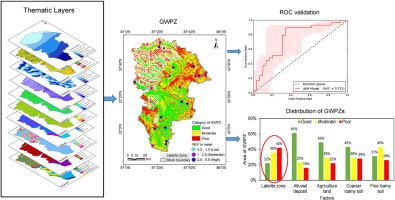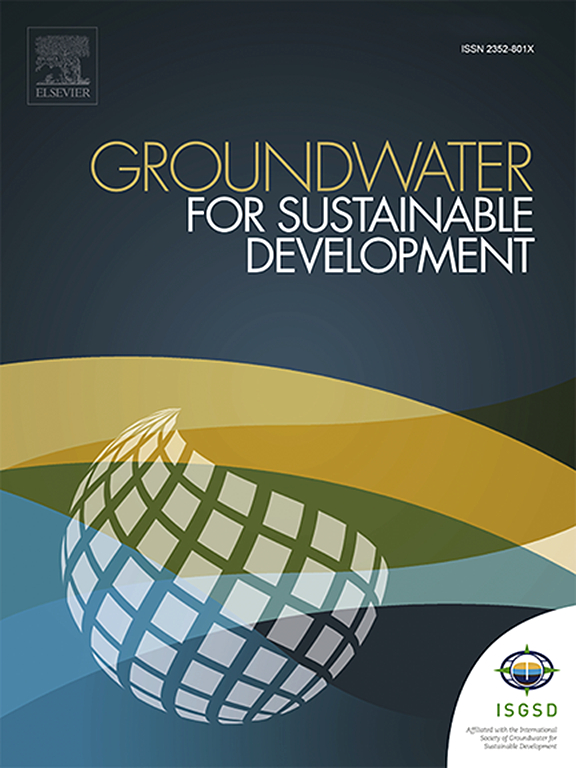Evaluating groundwater potential in water-deficit laterite zones of Eastern India using RS and GIS techniques, combining an analytical hierarchical process for sustainable water resources management
IF 4.9
Q2 ENGINEERING, ENVIRONMENTAL
引用次数: 0
Abstract
Sustainable groundwater management in water-deficit, laterite-dominated regions need urgent planning, which involve accurate identification of groundwater potential zones (GWPZs). While unsustainable water extraction has exacerbated groundwater availability in laterite zones, laterite is globally known for its limited groundwater potential but has received relatively little research attention. Therefore, the present study aims to examine the role of laterite formation on groundwater potentiality and its relationship with the stage of groundwater development in Paschim Medinipur district of West Bengal in eastern India. This study integrated cost-effective and efficient time-saving tools like remote sensing, and GIS and to produce thematic map layers for overlay analysis and analytical hierarchy process (AHP) to delineate the GWPZs precisely using n = 10 parameters, while a consistency check was performed prior to the integration of these parameters to ensure low subjectivity in the GWPZ. The three identified GWPZ classes cover 30% of ‘good’, 44% of ‘moderate’ and 26% of ‘poor’ zones. The yield data and water level fluctuation analysis revealed that 70% and 60% match the delineated GWPZs. The cross-validation with the receiver operating characteristic curve also demonstrated good (75.1%) prediction accuracy. We found that hydrogeological factors like laterite formations witness around 80% of moderate to poor GWPZ, while poor GWPZ covers half of the laterite belt. However, flood plains and valley fill deposits in the lateritic parts demonstrate moderate to good GWPZ, suggesting laterite formation at variable depths that control groundwater recharge potential. The laterite regions with lower groundwater recharge potential have experienced a 17% increase in water extraction compared to non-laterite areas. Whereas four blocks within the district are partly overlapped with laterite formations and poor GWPZ, which encounter high stages of groundwater development (70–90%), leading to semi-critical to critical conditions. It is attributed to anthropogenic perturbations and hydrogeological conditions, which need urgent planning to ensure sustainable groundwater usage.

利用 RS 和 GIS 技术评估印度东部红土缺水区的地下水潜力,结合层次分析法促进可持续水资源管理
缺水、红土为主地区的可持续地下水管理亟需规划,其中包括准确识别地下水潜力区(GWPZ)。不可持续的水资源开采加剧了红土地区的地下水供应,而红土因其有限的地下水潜力而闻名全球,但受到的研究关注却相对较少。因此,本研究旨在考察红土形成对地下水潜力的作用及其与印度东部西孟加拉邦 Paschim Medinipur 地区地下水开发阶段的关系。本研究整合了成本效益高且高效省时的工具,如遥感和地理信息系统,并生成了用于叠加分析和层次分析法(AHP)的专题图层,使用 n = 10 个参数精确划分了 GWPZ,同时在整合这些参数之前进行了一致性检查,以确保 GWPZ 的主观性较低。所确定的三个 GWPZ 等级覆盖了 30% 的 "好 "区、44% 的 "中 "区和 26% 的 "差 "区。产量数据和水位波动分析表明,分别有 70% 和 60% 的数据与划定的 GWPZ 相符。利用接收器工作特征曲线进行的交叉验证也显示出良好的预测准确率(75.1%)。我们发现,红土地层等水文地质因素见证了约 80% 的中度至较差 GWPZ,而较差 GWPZ 则覆盖了红土带的一半。然而,红土地区的冲积平原和河谷充填沉积显示出中等至良好的 GWPZ,这表明不同深度的红土层控制着地下水的补给潜力。与非红土地区相比,地下水补给潜力较低的红土地区的取水量增加了 17%。而该地区的四个区块有一部分与红土地层重叠,GWPZ 较差,地下水开发程度较高(70%-90%),导致半临界到临界状态。这归因于人为干扰和水文地质条件,需要紧急规划,以确保地下水的可持续利用。
本文章由计算机程序翻译,如有差异,请以英文原文为准。
求助全文
约1分钟内获得全文
求助全文
来源期刊

Groundwater for Sustainable Development
Social Sciences-Geography, Planning and Development
CiteScore
11.50
自引率
10.20%
发文量
152
期刊介绍:
Groundwater for Sustainable Development is directed to different stakeholders and professionals, including government and non-governmental organizations, international funding agencies, universities, public water institutions, public health and other public/private sector professionals, and other relevant institutions. It is aimed at professionals, academics and students in the fields of disciplines such as: groundwater and its connection to surface hydrology and environment, soil sciences, engineering, ecology, microbiology, atmospheric sciences, analytical chemistry, hydro-engineering, water technology, environmental ethics, economics, public health, policy, as well as social sciences, legal disciplines, or any other area connected with water issues. The objectives of this journal are to facilitate: • The improvement of effective and sustainable management of water resources across the globe. • The improvement of human access to groundwater resources in adequate quantity and good quality. • The meeting of the increasing demand for drinking and irrigation water needed for food security to contribute to a social and economically sound human development. • The creation of a global inter- and multidisciplinary platform and forum to improve our understanding of groundwater resources and to advocate their effective and sustainable management and protection against contamination. • Interdisciplinary information exchange and to stimulate scientific research in the fields of groundwater related sciences and social and health sciences required to achieve the United Nations Millennium Development Goals for sustainable development.
 求助内容:
求助内容: 应助结果提醒方式:
应助结果提醒方式:


